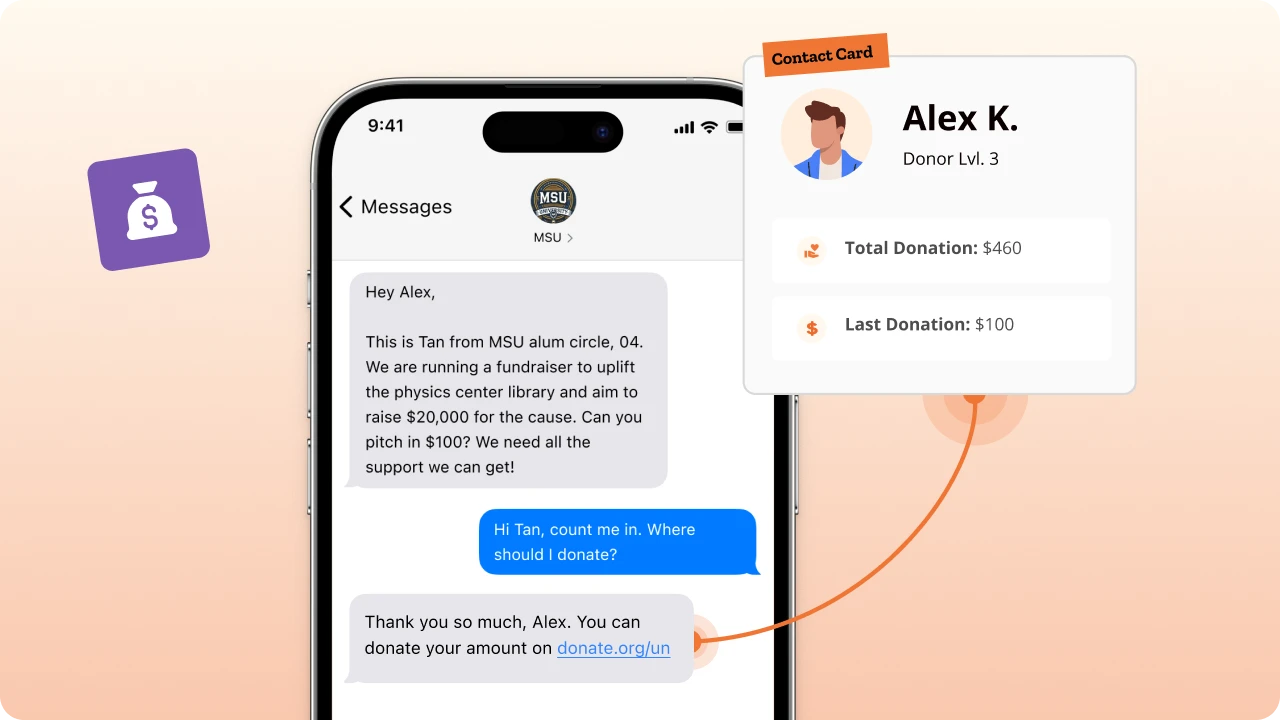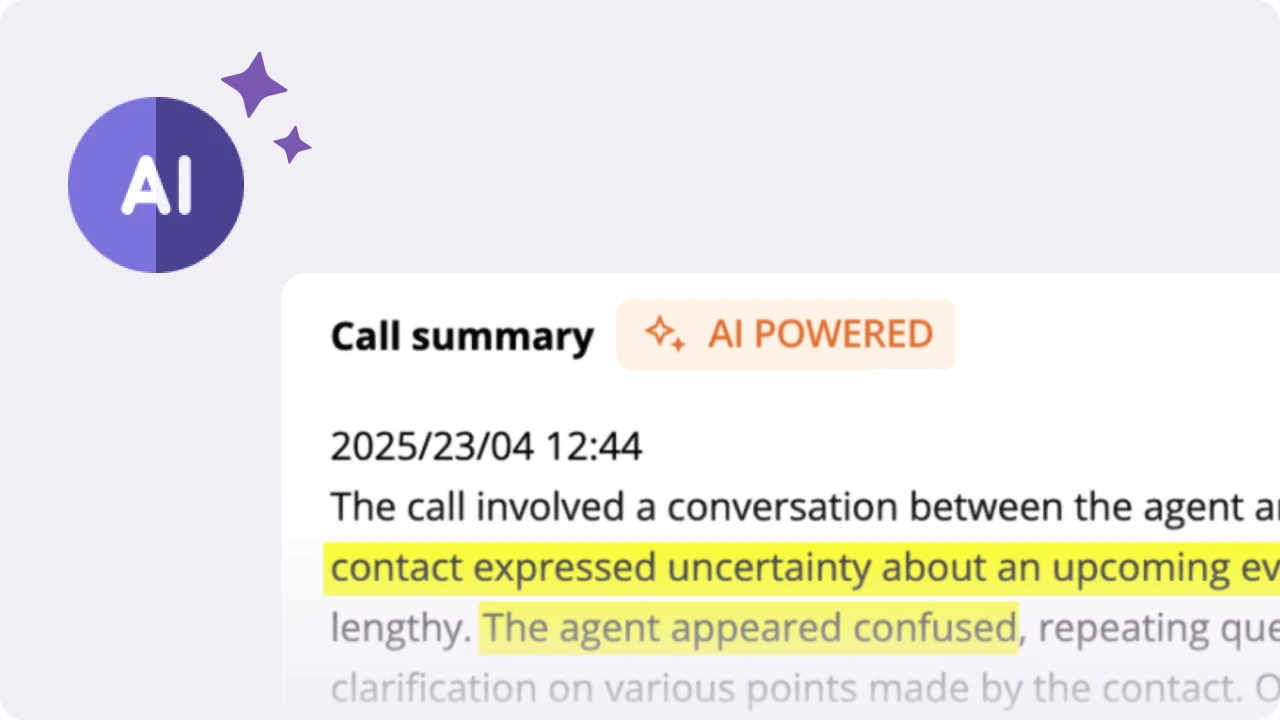Table of Contents
A year end donation thank you letter is a personalized message nonprofits send to supporters at the end of the year to express appreciation, reinforce impact, and encourage future giving. The best letters are specific, heartfelt, and donor-centric, never generic or robotic.
If you think in a line like
“On behalf of our organization, we would like to thank you for your donation!” is the focus of a perfect year end donation thank you letter; then you’ve got it all wrong.
An end-of-year thank-you note is meant to show donors how much you appreciate their specific support. A generic, uninspiring message that reads like it was written by a robot (like the one above) doesn’t do nonprofit organizations any favors.
Your year end donation thank-you letter is your opportunity to woo donors with genuine gratitude and spark that warm, fuzzy feeling that drives them to give again. Don’t waste it on generic and standard language. Use the insights below to write year end donation thank you letter that perform well, feel personal, and build donor loyalty.
Why every nonprofit needs a year end donation thank you letter
Yes, it shows appreciation, but it also directly impacts your fundraising success.
- Boosts donor retention:
A personalized thank you can make first-time donors 4X more likely to donate again. Therefore, a thank-you note can help you boost donor retention.
- Acts as a reminder:
For donors who didn’t plan to give again, your letter puts your organization and its mission back on their radar.
Read Also: The perfect nonprofit storytelling approach to drive action
- Strengthens emotional connection:
Taking the time to personalize a message makes donors feel valued and deepens their bond with you.
In short: a year end donation thank you letter doesn’t just wrap up the giving season, it fuels the next one.
Read Also: Psychology Of Giving Hacks To Hit The Fundraising Jackpot
Needless to say, a year end donation thank you letter helps you build a better relationship that ultimately boosts your future fundraising efforts.
Key benefit of sending year end donation thank you letter
Whether you’re mailing, emailing, or texting your appreciation, these elements are non-negotiable:
Here’s a thank you letter sent by the Glide Foundation in response to a donation. Let’s go over each component of the letter.
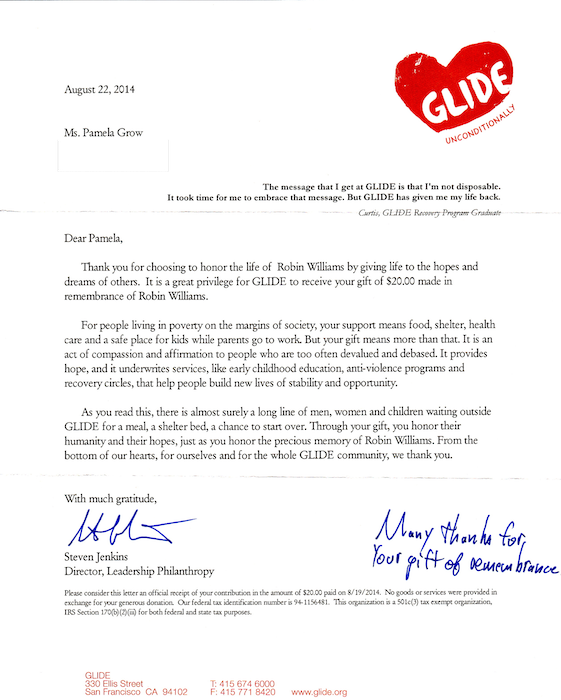
Let’s go over each component of the letter.
1. Personalized greeting

EStart with their name, not “Dear Donor”. Personalization helps you grab attention, set a warm tone, and show care. Adding a “preferred name” field to donation forms gives you even more customization, and you should personalize it to:
- Grab their attention and keep them reading on. When addressed by name, they know the letter is important.
- Set a positive, comfortable tone for the whole letter.
- Leave a positive impression about how you’ve crafted the letter, especially for them.
Making a difference often comes down to these small factors.
To personalize it even further, you can add a “preferred name” field in your donation forms and use that in your thank-you letter. Making a difference often comes down to these small factors.
Read Also: Donor Recognition: Best Practices to Nurture Donor Relationship
2. Specific thank you

After greeting the reader, get straight to the point, and thank them for their gift. Reference the actual donation amount or gift type. This ensures that:
- It doesn’t seem like a generic auto-generated thank you letter sent out to donors.
- Donors know that their gift (no matter the amount) is seen and appreciated.
- It signals authenticity and tells donors that every contribution is noticed and valued.
Segmenting your lists and merging the relevant tags while crafting the thank you letter can make this (and the greeting, too) easier.
3. A mission reminder

Many donors make “forget gifts” – one-off donations made to ease guilt, not engage long-term. Including a brief, story-driven mission summary reminds them why your work matters and why support should continue.
- Remind people what you’re trying to accomplish and why nonprofit organizations need their support.
- Deepen their interest in the cause and in driving change rather than just donating.
A plain mission summary or a reminder, however, won’t get you very far. Make sure that you leverage a storytelling approach with relatable beneficiaries to get the readers more invested.
*Forget Gifts
Forget gifts are gifts given so people can emotionally disengage from a problem. Rather than bringing change, donors are motivated to give because it means they no longer need to worry about an issue.
Your work isn’t a priority for them, which is why they may give smaller amounts and less frequently (typically just once). For more insights, check out this post: Focused and forget gifts
4. The impact

For deeply engaged donors, impact reinforces why their giving matters. Even if results are still unfolding, share what their contribution will accomplish or how it’s already helping.
- Reduces attrition– Failure to communicate the campaign results is one of the top reasons why donors leave.
- Motivates them to give again– Knowing that their donations make an impact will encourage them to give again and even get others to donate.
| Note: If it’s too early to convey the exact impact, letting them know what you will achieve later will also do. Make sure to keep them updated on the impact and let them know when you accomplish what you planned. If they attended any events, mention what a great time it was to have them there. |
Read Also: Donation Incentives: The Right Way To Use Them And Raise More Money
5. Closing
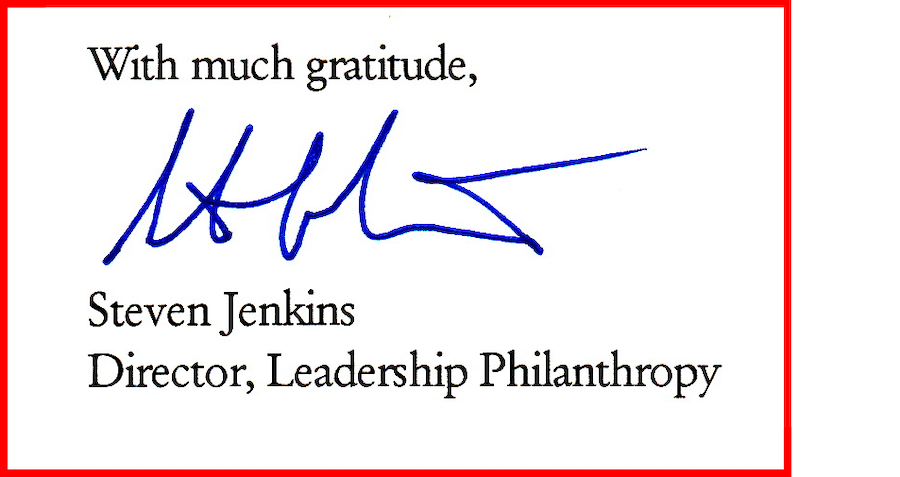
Sign off as a person, not “The Organization.” Donors connect with people and stories, not institutions. A director or key leader is ideal, but a volunteer’s voice can work for smaller donors, too.
- A year-end donation thank you note from a person feels more personal and appreciative.
- People respond better to people. So the next time you send a donation letter, they will be more likely to read and respond to it.
Keep in mind that it is essential to have all these elements in your thank-you letter. However, how you craft the specifics is up to you.
Read Also: How To Write The Perfect Church Donation Letter (With Letter Templates)
Here’s a sample of year end donation thank you letter template for your reference.
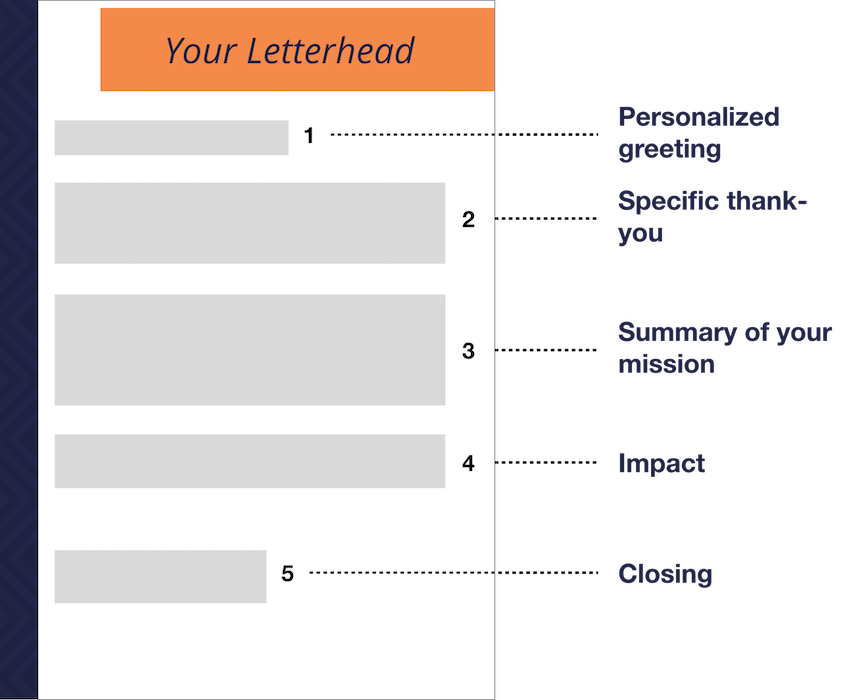
Read also: How To Write The Perfect Church Donation Letter (With Letter Templates)
Year end donation thank you letter best practices
These best practices lift performance and keep content from sounding stale:
- Make the letter about the donor, not you!
- Skip generic copy
- Add a handwritten note
- Include a powerful P:S
- Time it right
Let’s look at each of them in detail.
1. Make it about the donor, not you!
Use donor-centric language – “you made this possible” instead of “we achieved this.”
Rather than focusing on what you are accomplishing, make the donor the hero. Use phrases like:
- “You made it possible.”
- “Your generosity has helped us do this.”
- “Your gift was needed, and you’re a big deal for us.”
- “We couldn’t do it without you.”
Keep in mind, your year-end thank you letter should be to your donor, about your donor.
Read Next: Donor Appreciation Letter: Everything You Need To Know To Craft The Perfect One.
2. Skip generic copy
Avoid flat openers like “thank you for your support.” Swap them for vivid, specific lines that reflect the outcome of their gift:
- “John will go to sleep tonight with a full tummy because you cared.”
- “Because of your gift, Fatima’s water won’t make her sick.”
- Julia sees the world in color again because you helped her.”
3. Add a handwritten note
Even a short handwritten line dramatically boosts emotional connection and memorability.
The note doesn’t have to be too detailed. It can be something as simple as:
- “I genuinely appreciate the donation you made to our campaign.”
- “It’s an honor to write to such a generous person.”
- “Thank you for being a part of the family.”
You can add these notes at the end of the letter or wherever you have space.
4. Include a powerful P:S
Research shows donors often read the postscript first. Use it to invite engagement, share stories, gather feedback, or deepen participation. Just don’t ask for another gift there.
You can end with statements like:
- “P.S. We’d love to feature your testimonial in a story. Please write back to us if you’re interested.” – You can use the testimonial in your nurturing emails.
- “P.S. We’re sure you’ll know more amazing people who would also love to support our cause. Text SUPPORTER to 555055 to receive a message that you can share with your friends.” – You can set up a text message autoresponder to reply with a web page link with more details.
- “P.S. We’d love to get your feedback on things, and if there’s anything else we can do. Text SURVEY to 555055.” – You could set up an automated text survey to collect data and their feedback.
5. Time your year end donation thank you letter right
Donors thanked within 48 hours are far more likely to give again. If crafting a full letter fast isn’t feasible, send a quick personalized text, email, or call first, then follow with the full note within a week.
However, sending a personalized end-of-year thank you letter within this duration would be almost impossible. Here’s how you can work around that:
- Send them a brief thank you message that also mentions the letter you’ll send later. You can send this over email, text, or even a quick thank you call.
- Mail the appreciation letter after sending the message, preferably within a week.
Thanking them immediately will buy you some time to send a more personalized thank-you letter. Moreover, notifying them about the letter will also increase their chances of opening and reading it.
How should you send the first thank-you message?
While the first thank you message after the donation may not be the primary one, it still has to be personalized. A generic, automated message won’t work.
Send the first appreciation message over text. You can use a mass texting solution to schedule a personalized message with relevant tags. Know more about how they work here.
Why texts? For the following reasons:
- Texts are personal and direct. They won’t get lost in the digital noise, unlike emails.
- They have a 98% open rate. Therefore, you can be sure that donors will read the message.
Alternatively, even a quick thank-you call to donors would do very well if you have the resources.
To conclude
Crafting a standout year-end thank-you letter isn’t about formality; it’s about warmth, timing, detail, and personalization. And remember: this letter is just one of the essential donor “touches” that help you retain supporters long after December 31st.
Pair it with acknowledgement letters, follow-up calls, or storytelling emails to reinforce connection and inspire ongoing support.
Ready to strengthen donor relationships this giving season?
Use CallHub to send heartfelt thank-you messages, make personal donor calls, and automate follow-ups that keep your supporters engaged year-round.
FAQ on year end donation thank you letter
What key details should I always include in a year end donation thank you letter to maximize donor retention?
Every thank you letter should mention the donor’s name, the specific donation amount, the impact their gift made, and a clear connection to your nonprofit’s mission, showing how their support drives real change.
How soon after a donation should my organization send the year end thank you message?
Research shows that reaching out within 48 hours greatly increases the chance of receiving repeat donations; if that’s not feasible, send a prompt text or email and follow up with the personalized letter within a week.
What’s the most effective channel for sending a year end thank you, email, direct mail, text, or phone call?
For most CallHub users, a combination works best: Send a quick thank-you text or call immediately after a donation, then follow up with a more detailed email or mailed letter before year-end for maximum engagement.
How can I make our thank you letters feel genuinely personal and not like boilerplate?
Personalize every message with specific donor details (not just the name), recognize their exact contribution, reference any events attended or involvement, and add handwritten notes or a meaningful postscript for a more heartfelt touch.
Can a well-crafted year end thank you letter really affect future donations?
Absolutely. Personalized, timely thank you messages have been shown to make donors up to four times more likely to give again, especially when the message is donor-centric and communicates real impact.

